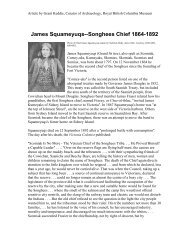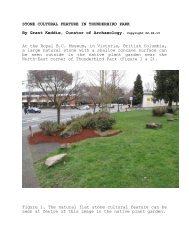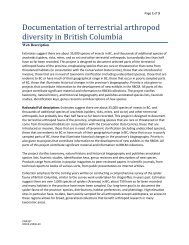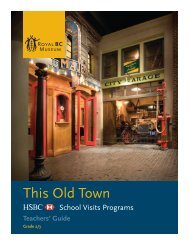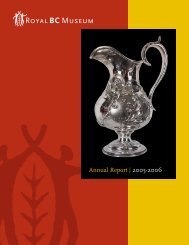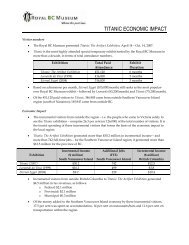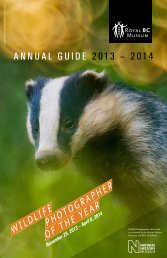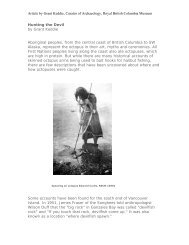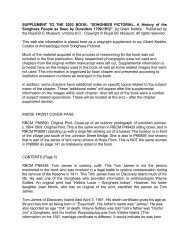Create successful ePaper yourself
Turn your PDF publications into a flip-book with our unique Google optimized e-Paper software.
<strong>NEWS</strong> <strong>RELEASE</strong><br />
News Release - [target date April. 2002]<br />
For Immediate Release<br />
[April. 2002]<br />
Chief Kwah’s famous dagger<br />
STUART LAKE--Chief Kwah’s dagger played a part in an event that changed the history of our Province.<br />
The oral histories of the Nak’azdli people of Stuart Lake tell us that a man named Kwah acquired the first<br />
iron dagger in the area over 225 years ago, and before the first Europeans appeared off our coast.<br />
Numerous articles have been written about an event where Kwah captured a young Hudson’s Bay Company<br />
clerk who failed to observe local Nak’azdli social traditions. This clerk was moved south - resulting in his<br />
becoming a strong and major player in the early events that led to the creation of our Province. The young<br />
clerk was James Douglas.<br />
In the early 1900s, a dagger, believed to be the original one passed down to Kwah’s grandson, Chief Louis<br />
Billy Prince, was brought into the media spotlight, but then disappeared. What ever happened to it?<br />
In 1998, a letter of enquiry arrived at the <strong>Royal</strong> <strong>BC</strong> <strong>Museum</strong> from an 89-year-old daughter of chief Louis Billy<br />
Prince. She remembered seeing her father’s dagger in the old <strong>Museum</strong> and wanted to know if we had it.<br />
“The <strong>Museum</strong> had daggers, but no record stating that any were Kwah’s dagger,” recalls Grant Keddie, R<strong>BC</strong>M<br />
Curator of Archaeology.<br />
Curious, the curator searched libraries, archives and anthropological collections for months, talked to the<br />
Nak’azdli people and tracked down anyone with a connection to the dagger.<br />
“With a little detective work and the help of many people, I pieced together the story,” says Keddie. He was<br />
able “to single out a specimen from the <strong>Royal</strong> <strong>BC</strong> <strong>Museum</strong> collection and prove that it was the dagger once in<br />
the possession of Chief Louis Billy Prince.”<br />
This story is part of the larger question. Did First Nations of B.C have iron tools before the contact period<br />
with Europeans?<br />
“Archaeological evidence shows some First Nations hammered natural nuggets of copper into artifacts 1800<br />
years ago,” adds Keddie. “However, no evidence has been found for the smelting of iron ore before the<br />
coming of Europeans in the 18 th century.”<br />
Yet in 1774, Spanish explorers in the Queen Charlottes were surprised to find an iron harpoon point, a<br />
broken bayonet, and a piece of sword made into a knife.<br />
Grant Keddie is examining First Nations oral traditions and other accounts of early iron distribution as part<br />
of the museum’s Living Landscapes initiative, a province-wide research and public education program of the<br />
<strong>Royal</strong> <strong>BC</strong> <strong>Museum</strong> that explores human and natural influences on regional environments. It offers British<br />
Columbians opportunities to learn about their cultural and natural heritage through its website:<br />
http://livinglandscapes.bc.ca.
Part I of Kwah’s Dagger can be seen on the <strong>Museum</strong>’s web site under Publications of Curators and Students.<br />
Part II will appear in an upcoming article in the May edition of the <strong>Royal</strong> <strong>BC</strong> <strong>Museum</strong>’s Discovery newsletter.<br />
Keddie will tell what he discovered about the more recent history of the dagger.<br />
The <strong>Royal</strong> British Columbia <strong>Museum</strong> is a publicly owned cultural, educational and historic institution that was<br />
founded in 1886. The museum is responsible for collecting, displaying and researching the human and natural<br />
history of British Columbia.<br />
This news release is online at: www.royalbcmuseum.bc.ca\newsreleases\index.html<br />
-30-<br />
Contact:<br />
Chris Higgins<br />
<strong>Royal</strong> <strong>BC</strong> <strong>Museum</strong><br />
250-387-2101<br />
cahiggins@royalbcmuseum.bc.ca



